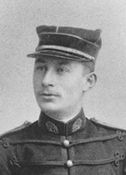 Getting credit for a great scientific discovery is sometimes just a matter of luck. You all know that penicillin can be made by fungi to kill bacteria, but most of you do not know the sad story that more than 120 years ago, antibiotics were first discovered by an obscure medical student who was told by stable boys that storing horseback saddles in damp and dark moldy places prevented horses from developing saddle sores and riders from suffering groin infections. He did all the right experiments and as a medical student, published them in 1897 in scientific journals, but his research was largely ignored because he died, poor and unknown, at a very young age from tuberculosis before the world could give him credit for one of the most important discoveries ever in medicine.
Getting credit for a great scientific discovery is sometimes just a matter of luck. You all know that penicillin can be made by fungi to kill bacteria, but most of you do not know the sad story that more than 120 years ago, antibiotics were first discovered by an obscure medical student who was told by stable boys that storing horseback saddles in damp and dark moldy places prevented horses from developing saddle sores and riders from suffering groin infections. He did all the right experiments and as a medical student, published them in 1897 in scientific journals, but his research was largely ignored because he died, poor and unknown, at a very young age from tuberculosis before the world could give him credit for one of the most important discoveries ever in medicine.
The “Discovery” of Penicillin
In 1928, 31 years after Duchesne’s publication of the discovery of penicillin, Alexander Fleming placed a bacterial culture in his incubator and came back the next morning to see circular dots of fungi invading the culture plate that he had laid out the night before. He noticed that everywhere the fungus grew, the bacteria did not. He felt that something in the fungus must be keeping bacteria from growing on the bacterial culture plate. However, Fleming was not smart enough to extract the chemical in the fungus that kept bacteria from growing, and he did not show that penicillin could be used to save people’s lives by curing bacterial infections. So, like Duchesne, he was not given credit for discovering penicillin, until he was saved by Drs. Chain and Florey when they published their brilliant research on penicillin and gave him credit. In 1945, Fleming was awarded the Nobel Prize in Medicine along with Chain and Florey, and became Sir Alexander Fleming.
The Obscure Ernest Duchesne
Ernest Duchesne was born in Paris in 1874. He began medical school in 1894 and was graduated in 1897 from l’Ecole du Service de Santé Militaire in Lyon. While he was still a student, he saw that the Arab stable boys at the army hospital stored their saddles in a dark and damp room to encourage mold to grow on them. They told him that mold helps to heal saddle sores on horses and prevent saddle sores in their riders. Duchesne made a solution of the mold that grew on the saddles and injected it into a pig at the same time he injected enough typhoid fever bacilli to kill the pig. The pig did not die (Hist Sci Med, 2002 Jan-Mar;36(1):11-20).
In 1897, Duchesne submitted his research as his doctoral thesis, “Contribution to the study of vital competition in micro-organisms: antagonism between molds and microbes.” This was the first medical report of curing bacterial infections with mold. However, doctors at the Pasteur Institute ignored his thesis, probably because he was an unknown 23-year-old who did not even have his medical degree. Soon after he received his degree, Duchesne was drafted into the French army and was appointed a 2nd class Major of Medicine in the 2nd Regiment de Hussards de Senlis. This prevented him from doing further research that could have made him one of the most famous doctors of all time. In 1901, he married Rosa Lassalas from Cannes. She died two years later of tuberculosis. This left him heartbroken and also with tuberculosis. He was sent to a sanatorium and wandered from one health center to another until he died of tuberculosis in 1912, at age 37. He is buried next to his wife in Cannes. The world did not know that personal tragedies prevented him from following up research that could have introduced antibiotics to cure infections 40 years earlier than Fleming, Chain and Florey, who received all the credit along with the Nobel prize.
Credit Long After Death
Thirty years before Fleming’s discovery, Ernest Duchesne had extracted the chemical from mold that he used to cure bacterial infections. His work with mold was so revolutionary that his contemporaries in Paris found it difficult to believe that infections such as anthrax and typhoid fever could be cured by injecting mold extracts into an infected person. The world forgot Duchesne until 34 years after his death when Ramon and Richou published a summary of his medical school thesis (le Progrés Médical, 1946). In 1999, the British medical journal Lancet published a tribute to Ernest Duchesne and called him “The father of antibiotic therapy”. He died unknown, but is remembered now when he is not around to hear the applause (The Lancet, December 11, 1999;354(9195):2068 – 2071).
Ernest Duchesne
May 30, 1874 – April 12, 1912

